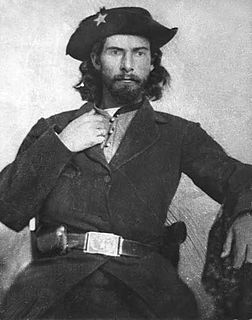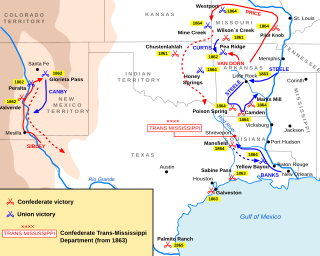| Livingston's Hideout | |
|---|---|
| Cherokee County, Kansas | |
| Coordinates | 37°01′31″N94°37′16″W / 37.0253°N 94.6210°W Coordinates: 37°01′31″N94°37′16″W / 37.0253°N 94.6210°W |
| Type | guerrilla hideout |
| Site information | |
| Controlled by | Confederate guerrillas |
| Site history | |
| Built | ca. spring 1862 |
| In use | ca. spring 1862 to ca. summer 1863 |
| Garrison information | |
| Past commanders | Major Thomas R. Livingston |
| Garrison | same |
Livingston's Hideout was most likely the only permanent Confederate military camp inside Kansas during the Civil War. It was in the very corner of southeast Kansas, in the very corner of Cherokee County, Kansas. It was about 2 miles (3.2 km) north of the border with Indian Territory and it was less than 100 feet (30 m) west of the border with Missouri. It was 5 miles (8.0 km) west of Baxter Springs, where a series of Union military posts existed from 1862 to 1863. Thomas R. Livingston became a leader of a group of Confederate guerrillas in the area, becoming first a captain and then a major. He needed locations to hide himself and his guerrillas from pursuing Union troops and this hideout suited the guerrillas well. The guerrillas sought to spy on Union forces and raiding units he found small enough to defeat. [1] [2]
A military camp or bivouac is a semi-permanent facility for the lodging of an army. Camps are erected when a military force travels away from a major installation or fort during training or operations, and often have the form of large campsites.

Kansas is a U.S. state in the Midwestern United States. Its capital is Topeka and its largest city is Wichita, with its most populated county being Johnson County. Kansas is bordered by Nebraska on the north; Missouri on the east; Oklahoma on the south; and Colorado on the west. Kansas is named after the Kansas River, which in turn was named after the Kansa Native Americans who lived along it banks. The tribe's name is often said to mean "people of the (south) wind" although this was probably not the term's original meaning. For thousands of years, what is now Kansas was home to numerous and diverse Native American tribes. Tribes in the eastern part of the state generally lived in villages along the river valleys. Tribes in the western part of the state were semi-nomadic and hunted large herds of bison.

The American Civil War was a war fought in the United States from 1861 to 1865, between the North and the South. The Civil War is the most studied and written about episode in U.S. history. Primarily as a result of the long-standing controversy over the enslavement of black people, war broke out in April 1861 when secessionist forces attacked Fort Sumter in South Carolina shortly after Abraham Lincoln had been inaugurated as the President of the United States. The loyalists of the Union in the North proclaimed support for the Constitution. They faced secessionists of the Confederate States in the South, who advocated for states' rights to uphold slavery.
No one knows when Livingston found his hideout, but he possibly began using it in spring 1862. No Union troops knew of its existence during the Civil War. The campsite was in a heavily wooded area. A road runs just west of the campsite and is about 100 feet (30 m) above it. The area of the campsite cannot be seen from the road, as it is in the woods and the area beyond the road drops off sharply before the camp begins. The site is flat and somewhat oval shaped. It is 100 feet (30 m) wide and 200 feet (61 m) long. A creek is about 50 feet (15 m) below the campsite and a hill to the east, inside Missouri, is on the east side of the creek, about 50 feet (15 m) above the campsite. The creek runs through a long valley. This camp would have been almost in plain sight, yet invisible. [3]
The use of Livingston's hideout proved a great frustration for the area's Union troops. Many times the troops chased the guerrillas, only to have them scatter and seemingly vanish. The hideout was used at least July 1863, when Livingston was killed in a fight with Union troops in Stockton, Missouri. After its use ceased, it was not rediscovered until after the War. Eventually, in the 1980s someone decided to build a house there and Betty Kyrias, of the Baxter Springs Historical Society, discovered the site yet again. [4] [5]

Stockton is a city in Cedar County, Missouri, United States. The population was 1,819 at the 2010 census. It is the county seat of Cedar County.






